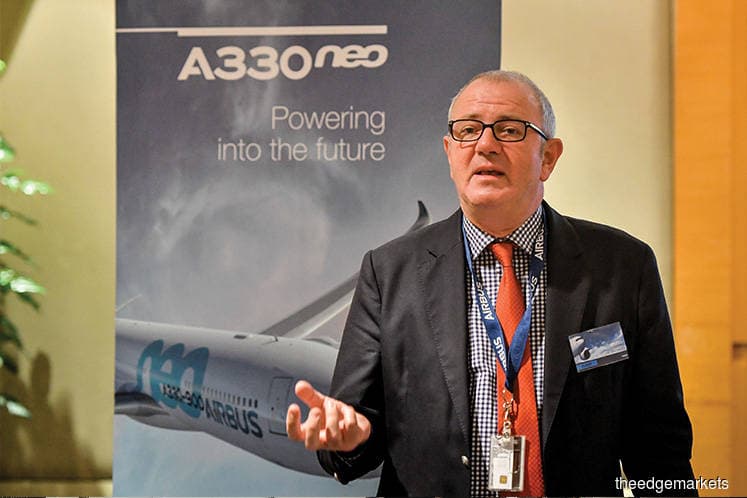
This article first appeared in The Edge Financial Daily on July 9, 2018
KUALA LUMPUR: The number of aircraft in the Asia-Pacific is expected to almost triple over the next two decades to 17,000 from 6,000 currently. It remains the fastest-growing region of the world, mainly driven by the rapid growth of passenger traffic, said European plane manufacturer Airbus SE.
Airbus head of communications for Asia-Pacific Sean Lee said the future demand for air travel will be driven by the rapid rise of the middle-income group in the region.
“The Asia-Pacific region has shown a stronger growth compared with any other regions for air travel. The passenger traffic is estimated to grow at a pace of 5% per year over the next 20 years,” Lee told reporters during a route-proving exercise of its latest A330neo between Kuala Lumpur and Jakarta recently.
In its Global Market Forecast 2018-2037, Airbus projected the growth drivers include private consumption increasing 2.4 times in emerging economies, higher disposable incomes and a near doubling of the middle classes globally.
On top of that, it observed that emerging countries will account for over 60% of economic growth, with trips per capita to multiply 2.5 times for these nations.
With a strong demand forecast in sight, Airbus is set to further strengthen its leadership position in the Asia-Pacific region with its latest model — the A330neo.
Lee is upbeat on the new model, adding that “its existing A330 Family has been extremely popular in this region. Currently, there are about 600 A330s flying with 37 airlines in Asia-Pacific, including AirAsia X Bhd (AAX) and Malaysia Airlines Bhd”.
Airbus is betting big on A330neo aircraft sales, which is an upgraded version of Airbus’ most popular wide-body aircraft that is scheduled to enter into service in the third quarter of this year, Lee said.
“We got over 200 orders for A330neos, including AAX,” said Lee. The airline has ordered 66 A330-900s for delivery from 2020.
According to Airbus, it is maintaining a leading share of the Asia-Pacific market for both single-aisle and wide-body aircraft. The A330 is the most popular widebody aircraft in the region, accounting for 60% of market share, while its A320 Family dominates half of the single-aisle aircraft in the region.
The 2014 list price of the A330neo is US$296 million (RM1.19 billion). It features significant fuel efficiency as this new aircraft comes with the latest Rolls-Royce Trent 7000 engines, a new optimised wing and increased use of lighter composite materials.
“These advances bring a significant reduction in fuel consumption of 25% compared with older-generation aircraft of similar size. These advantages, combined with attractive acquisition costs, make the A330neo the most competitive and best-performing aircraft in its size category,” said Lee.
“The wings of this latest generation also have been redesigned, while the Rolls-Royce engines help push down fuel consumption,” he added.
Lee believes the A330neo will meet the requirements of airline operators in Asia, as it is designed to operate both on regional and long-haul flights. The aircraft can serve markets from as short as 30 minutes to over 15 hours flying time.
The A330neo also offers flexibility in terms of seat numbers, with the A330-800 version seating around 250 passengers in three classes and up to 400 in an all Economy layout, and the larger A330-900 offering accommodation for around 300 in three classes or up to 440 in a high-density single class configuration.
Lee said the A330-800 can fly up to 8,150 nautical miles (15,094 km) and 7,200 nautical miles for the A330-900.
“This enables both versions to operate direct services with the full payload from Southeast Asia to Europe, including from Kuala Lumpur to London non-stop,” he added.
On the route-proving exercise, Lee said Kuala Lumpur was chosen as the base of the A330neo during the Asian segment of the trials as it is home to the world’s largest A330neo customer — AAX. The exercise is part of the final phase of test flights leading to the certification of the aircraft and its delivery to launch customer TAP Air Portugal.